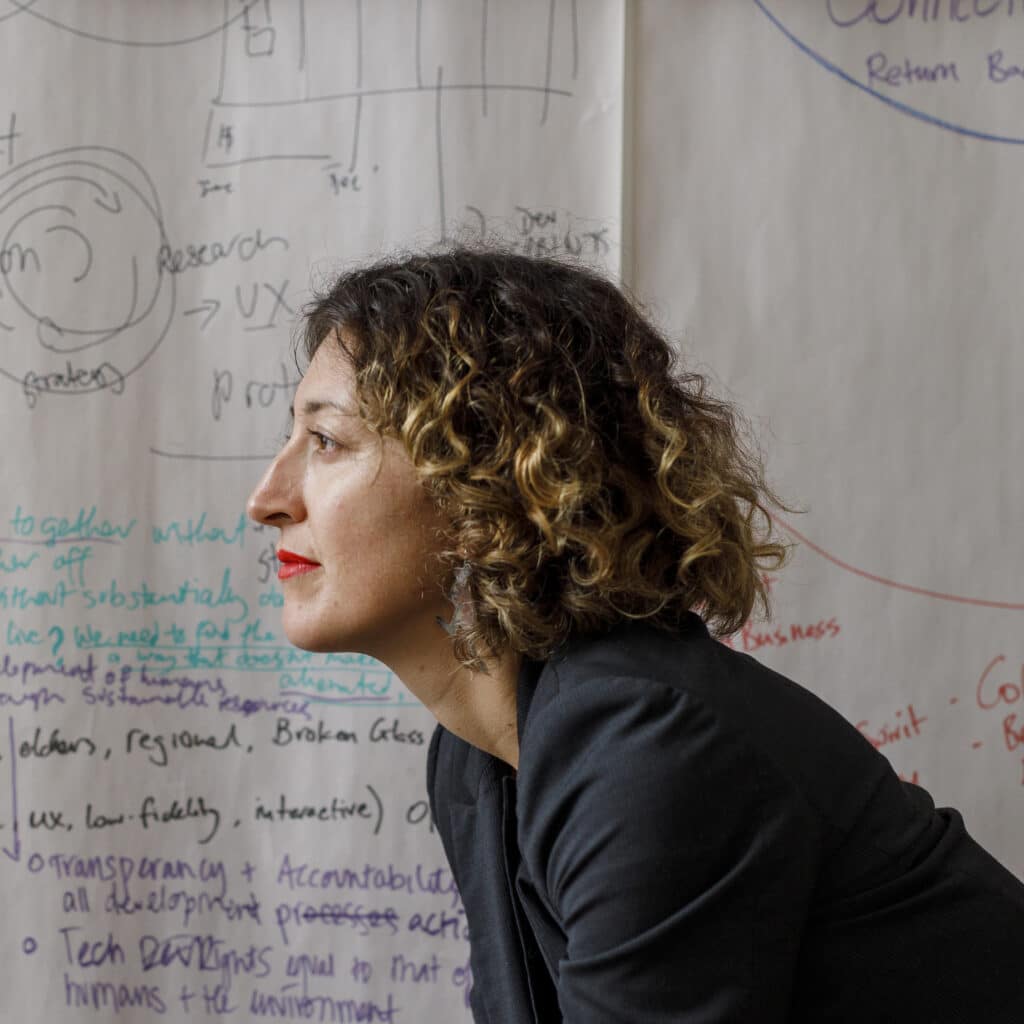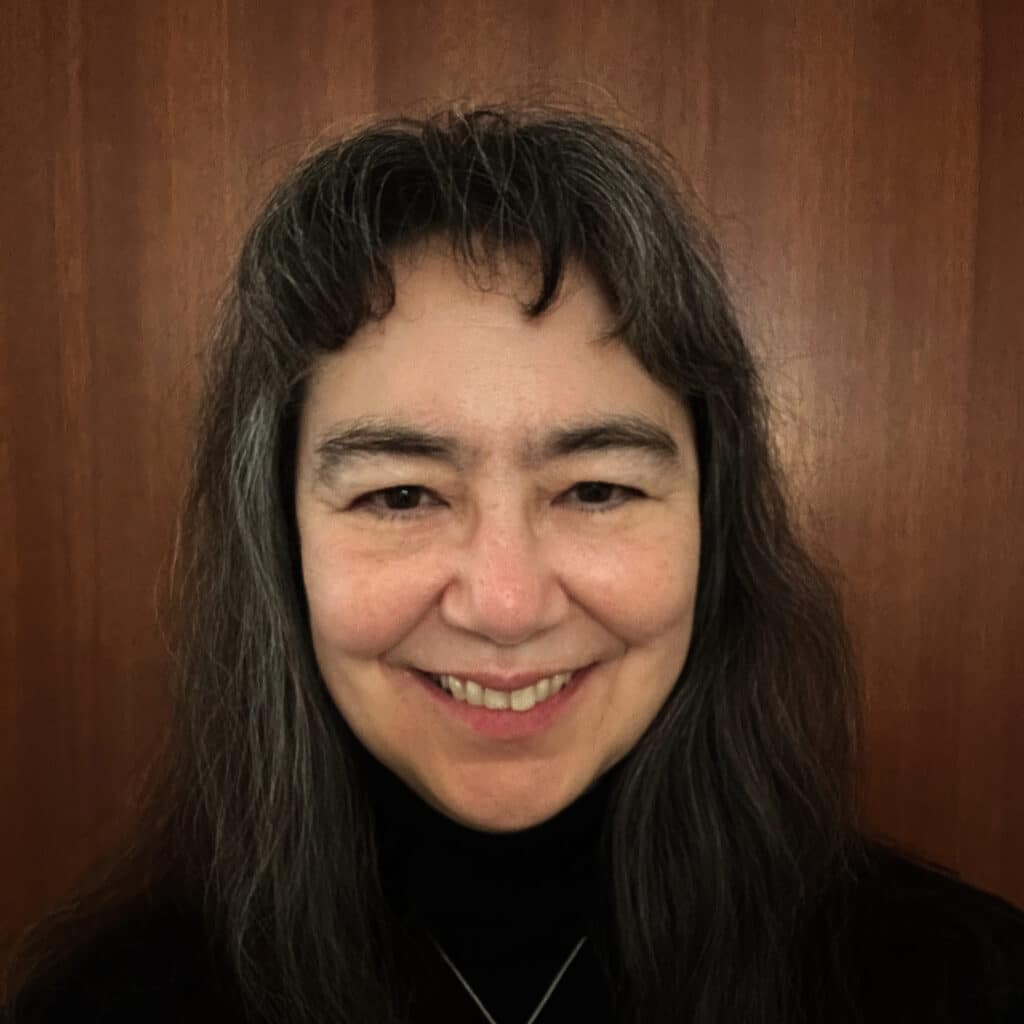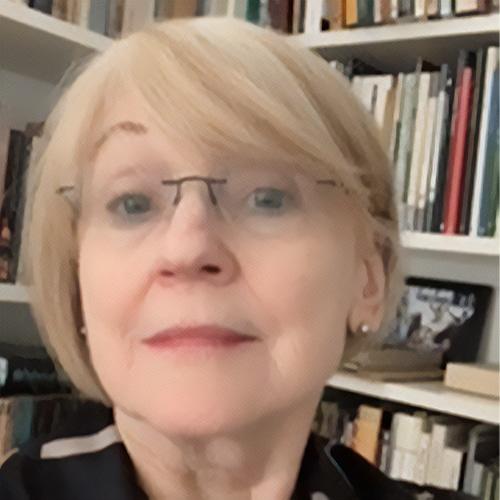Invited keynote speakers
Symposium keynote speakers

Professor Angie Abdilla
Founder, Director, Old Ways
Professor Angie Abdilla, palawa is the founder and director of Old Ways, New. She created the company’s strategic design methodology, Country Centered Design, leading projects for the public and private sectors over the past decade. She is an Advisor to the federal government for Services Australia, the Attorney General’s Copyright and AI Reference Group, CSIRO’s Data61, and the National AI Centre Think Tank, and previously was a member of the Global Futures Council on Artificial Intelligence for Humanity as part of the World Economic Forum. In her professorial role at the Australian National University’s School of Cybernetics, she works with Indigenous knowledges, systems, and technology as a cultural practice. Her published research explores Indigenous deep-time technologies and Artificial Intelligence, informed by the Indigenous Protocols and AI working group (IP//AI), which she co-founded.

Tamiko Thiel
Tamiko Thiel Studio
Tamiko Thiel was awarded the 2018 SAT Montreal Visionary Pioneer Award for now over 35 years of politically and socially critical media artworks exploring place, space, the body and cultural identity. She was lead project designer of the Connection Machine CM1/CM2 AI supercomputers (1986/1987), which influenced Google’s AI technology and Steve Jobs‘ designs. In 1989 a CM-2 was the fastest computer in the world; one is now in the design collection of MoMA NY. Her first virtual reality (VR) work was as producer/creative director on Starbright World, the first metaverse for children, in collaboration with Steven Spielberg. Her own VR large projection installation Beyond Manzanar was probably the very first VR artwork acquired by a US art museum when it was bought in 2002 by the San Jose Museum of Art. Her second VR artwork Travels of Mariko Horo was supported by the Japan Foundation, the Kyoto Art Center and MIT Center for Advanced Visual Studies, and the more recent VR Land of Cloud (2017) was created as Google Tilt Brush artist in residence. She began working in augmented reality (AR) art as part of the pathbreaking AR intervention into MoMA NY „We AR in MoMA“ in 2010, and led the Manifest.AR artist group’s intervention into the Venice Biennial in 2011. Her AR art commissions include Unexpected Growth in 2018 for the Whitney Museum New York (now in the collection), ReWildAR for the Smithsonian Institution’s 175th anniversary in 2021, ARpothecary’s Garden (2021) for the collection of the Swiss pharmaceutical giant Roche Basel, and Vera Plastica (2023) for the collection of the BROICH Digital Art Museum in Germany.
Tamiko Thiel began creating VR artworks soon after they were first possible on PCs in the early/mid 1990s, and AR artworks soon after they were first possible on mobile devices in 2010. She will discuss choices and strategies for using young technologies to address complex social and cultural themes, and finding a balance between exploiting the new possibilities of such technologies while still reaching large and diverse audiences.

Postcommodity
Leonardo Artist Fellows
Postcommodity is an interdisciplinary art collective comprised of Cristóbal Martínez (Genizaro, Manito, Xicano), and Kade L. Twist (Cherokee). Postcommodity’s art functions as a shared Indigenous lens and voice to engage the assaultive manifestations of the global market and its supporting institutions, public perceptions, beliefs, and individual actions that comprise the ever-expanding, multinational, multiracial and multi-ethnic colonizing force that is defining the 21st Century through ever increasing velocities and complex forms of violence. Postcommodity works to forge new metaphors capable of rationalizing our shared experiences within this increasingly challenging contemporary environment; promote a constructive discourse that challenges the social, political and economic processes that are destabilizing communities and geographies; and connect Indigenous narratives of cultural self-determination with the broader public sphere.
Postcommodity are the recipients of grants from the Joan Mitchell Foundation (2010), Creative Capital (2012), Art Matters (2013), Native Arts and Cultures Foundation (2014), Mid Atlantic Arts Foundation (2017), Ford Foundation Art of Change Fellowship (2017-2018), Harker Fund of the San Francisco Foundation (2018-2019), Native Arts and Cultures Foundation Shift Award (2021), Hewlett 50 Arts Commissions (2022), and the Latinx Artist Fellowship (2023-2024). The collective has been exhibited nationally and internationally, including: Contour the 5th Biennial of the Moving Image, Mechelen, BE; Nuit Blanche, Toronto, CAN; Adelaide International 2012, Adeliade, AUS; 18th Biennale of Sydney, Sydney, AUS; Scottsdale Museum of Contemporary Art, Scottsdale, AZ; 2017 Whitney Biennial, New York, NY; Art in General, New York, NY; documenta14, Athens, GR and Kassel, DE; the 57th Carnegie International in Pittsburgh, PA; Desert X, Coachella Valley, CA; Art Institute of Chicago, Chicago, IL; LAXART, Los Angeles, CA; Minneapolis Institute of Art, Minneapolis, MN; Remai Modern Museum, Saskatoon, CAN; and their historic land art installation Repellent Fence at the U.S./Mexico border near Douglas, AZ and Agua Prieta, SON. The collective was awarded the Fine Prize for From Smoke and Tangled Waters, They Carried Fire Home, commissioned for the 57th ed. Carnegie International.
Postcommodity acknowledges the important contributions of its previous collaborators: Raven Chacon (2009-2018), Steven Yazzie (2007-2010), Nathan Young (2007-2015), Adam Ingram-Goble (Game Remains), Andrew McCord (If History Moves at the Speed of Its Weapons, Then the Shape of the Arrow is Changing, and Promoting a More Just, Verdant and Harmonious Resolution), Annabel Wong (Dead River) and Existence AD (Dead River).
Postcommodity is represented by Bockley Gallery, Minneapolis, MN.
In their keynote, Postcommodity highlights the important roles that worldviews play in immersive art and interaction design. In the context of acceleration with profound resource limitations, they discuss the challenges of empathy, listening and consensus-building, and the dilemmas associated with the intersubjective negotiation of meaning across ways of being, knowing, and believing.

Tiare Ribeaux
Leonardo Exchange Lead Artist
Tiare Ribeaux is a Kānaka ‘Ōiwi filmmaker, artist, and creative producer based in Honolulu, Hawai‘i. Her films disrupt conventional storytelling methods by employing magical realist explorations of spirituality, labor, and the environment to critique both social and ecological imbalances. Her work uses components of speculative fiction and fantasy to reimagine both our present realities and future trajectories of healing, queerness, lineage, and belonging. Ribeaux’s work traverses between the mundane and dreamworlds – creating stories around transformation and how our bodies are inextricably linked to land and water systems. She integrates immersion within community, personal/ancestral narratives, and Hawaiian cosmology into her films. Her work often combines with installation elements to create immersive and expanded media experiences. Outside of film festivals, she has shown her work at galleries and museums – in single-channel formats, multi-channel, live cinematic performances, and augmented reality.
She has shown work both nationally and internationally, and has won numerous grants and awards for her artistic leadership including the Creative Capital Award, the NDN Radical Imagination Grant, the Native Lab Fellowship and Indigenous Film Fund from Sundance, two New and Experimental Works Grants from the Kenneth Rainin Foundation, the Building Demand for the Arts Grant from the Doris Duke Foundation, the Citizen Diplomacy Action Fund from the U.S. Department of State’s Bureau of Educational and Cultural Affairs, the Zellerbach Family Foundation, and the Center for Cultural Innovation, among others. She has given guest lectures at conferences and universities including Stanford, MIT, UC Berkeley, UH Manoa, RPI, and the school of ATEC at UC Dallas.
She served as Artistic Director at B4BEL4B Gallery for 8 years, curated and produced various media arts and performance festivals including the Soundwave Biennial and the Codame Festival, and taught international media arts workshops in Kyiv, Ukraine (2018) as lead artist for the American Arts Incubator and Ōtepoti, Aotearoa (2023) as part of Leonardo’s Creative Impact Lab exchange program.
Poetics, Metaphor and Healing Through Moving Image and Expanded Media
Tiare Ribeaux will overview of her practice, philosophies, and processes in filmmaking and expanded/new media arts grounded in Kānaka epistemologies, as well as her collaborative work within artist and activist communities. She will also discuss the works of hers that will be showcased at ISEA2024, including exhibition excerpts from the recent Leonardo Creative Impact Lab exchange she led in Ōtepoti Dunedin, Aotearoa New Zealand.
Doctoral Colloquium keynote speaker

Dr Linda Candy
Writer and Researcher
Dr Linda Candy is a writer and researcher with a deep and enduring interest in how creative practitioners think, act and make creative works. For over 30 years, she has studied the work of artists, designers and technologists focusing on the role of digital systems in amplifying and transforming their creativity. Her book The Creative Reflective Practitioner (2020) gives direct voice to contemporary creative artists and provides insights into the nature of artistic practice and how reflection plays a vital role in creativity. Her previous books include Explorations in Art and Technology (2002, 2018), Interactive Experience in the Digital Age: Evaluating New Art Practice (2014) (with Dr Sam Ferguson) and Interacting: Art, Research and the Creative Practitioner (2011) (with Professor Ernest Edmonds). Her most recent publication in which she authored leading chapters and acted as consulting editor is The Routledge International Handbook of Practice-Based Research (2022) (with Professors Craig Vear and Ernest Edmonds). She also writes poetry and travel journals. She is influenced by the writings of great authors of the past and is an avid reader still. Most of all, she is inspired by the dedication and determination of the many creative people she has met over her working life.
This keynote will explore how practitioners become researchers who create new knowledge through making artefacts. Creative reflective practice is central to the process and in practice-based research, it has become a core research method which can be used to record and interpret emerging knowledge. The talk draws upon my research into creative practice and experience in working with practice-based researchers across different disciplines. Three areas will be discussed:
- reflective practice and its variants as a method in practitioner research
- the artefact in practitioner knowledge development
- practice and research in the world and in academic contexts
I will draw on cases studies of practitioner researchers undertaking post doc projects and show how reflection has been important in artefact and problem led research practices.
ISEA2024 acknowledges the Turrbal and Yugara as the First Nations owners of the lands where the symposium will be held. We pay our respects to their elders, lores, customs and creation spirits. We also acknowledge and pay respects to all First Nations peoples across the continent and beyond Australian shores.

